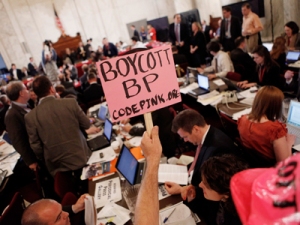
In a letter to the commission, the investigator, Fred Bartlit, said the cement mixture used on the well did not meet industry standards, and failed three out of four laboratory tests before the Deepwater Horizon explosion on 20 April.
Halliburton, which was hired by BP to cement the well, learned of those failures in February, and informed BP on 8 March. But both firms chose to go ahead with the nitrogen foam cement mixture, which was supposed to secure the bottom of the well.
“Halliburton (and perhaps BP) should have considered redesigning the foam slurry,” the letter said.
However, Halliburton said it did not believe that the foam cement design used on the well caused the incident. “Halliburton believes that significant differences between its internal cement tests and the commission’s test results may be due to differences in the cement materials tested,” the company said in a statement issued in response to the letter. “The commission tested off-the-shelf cement and additives, whereas Halliburton tested the unique blend of cement and additives that existed on the rig at the time Halliburton’s tests were conducted.”
The company added: “Halliburton believes that had BP conducted a cement bond log test, or had BP and others properly interpreted a negative pressure test, these tests would have revealed any problems with Halliburton’s cement.”
A fourth test, performed in April, did indicate the cement would hold. But Bartlit said BP did not have the results of that test before 19 April, when it ordered work crews to begin pumping cement into the well.
The finding offers some good news for BP, whose own investigative report on the spill last month zeroed in on problems in the cement seal performed by Halliburton.
Like BP’s investigators, the commission conducted its own tests on the cement design used by Halliburton – although they had an exact recipe. The mixture failed all nine stability tests.
The companies involved in the catastrophic spill – BP, Transocean, which owned the rig, Halliburton, and others – are engaged in a high stakes fight to shift blame, and millions of dollars in liability, for the explosion and spill.
Bartlit cautioned that the failure of the cement seal alone was not the sole cause for the oil disaster.
“The story of the blowout does not turn solely on the quality of the Macondo cement job. Cementing wells is a complex endeavour and industry figures inform us that cementing failures are not uncommon in the best of circumstances,” he wrote.
The oil industry had developed other common tests to ensure against cement failures, he said. “BP and/or Transocean personnel misinterpreted or chose not to conduct such tests at the Macondo well.”
Suzanne Goldenberg and Julia Kollewe


We stumbled over here by a different web page and thought I might check things
out. I like what I see so now i’m following you.
Look forward to exploring your web page yet again.